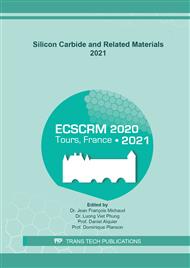p.49
p.54
p.59
p.64
p.69
p.74
p.79
p.84
p.89
Impact of N Doping on 3C-SiC Defects
Abstract:
This work studies the variation of the defects density of in situ doped 3C-SiC layers during heteroepitaxial Chemical Vapour Deposition (CVD). A review on the evolution of defects density as a function of 3C-SiC grown thickness, for different N doping concentrations is offered. The doping range spanned in the experiment suits the realization of power devices.The outcome of this work provides an explanatory picture of the significant drop in stacking faults density by roughly an order of magnitude through the N doping at concentrations of the order of ~2.9×1019 cm-3 during the growth. Conversely, N doping shows to favor the development of dislocation-like defects within the crystalline matrix. However, in few um, the crystal is able to display an effective dislocation closure mechanism, which rapidly recovers crystal quality.
Info:
Periodical:
Pages:
69-73
Citation:
Online since:
May 2022
Keywords:
Permissions:
Share:
Citation:


